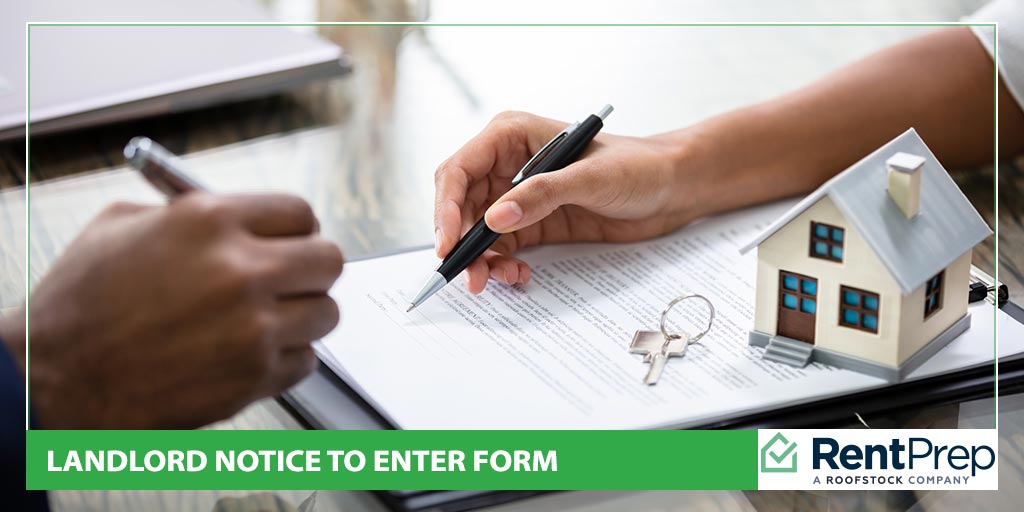
When you sign a lease with a tenant, they gain primary control of the property during their lease period. This means that anytime that you need to enter the property, you are legally required to give them notice about when and why you will be entering the property.
While it might seem like a simple thing to just enter and handle your management business when the tenants are not home, doing this is a huge mistake. You can be legally prosecuted against for doing that, so make sure that you use our landlord notice to enter form to avoid this issue.
Giving notice is a must. Let’s talk about how to let the tenant know you need to enter the residence as well as what to include in your notice.
A Table of Contents For Notice to Enter Apartment Form
- Legal Entry Obligations
- What is a Notice to Enter?
- When to Use This Notice
- Our Sample Notice to Enter Dwelling Form
Legal Entry Obligations
As a landlord, you are legally required to follow certain rules and procedures. One area that is often legally restricted are the times, hours, and reasons that you can enter any tenant-occupied property. Because you have leased the property to the tenant, you are no longer allowed to come-and-go at any time.
Nearly every state and municipality has specific rules about the following:
- When you can enter a property
- Why you can enter a property
- How much notice you must give before entering a property
- When you are allowed to enter a property without notice
When You Can Enter a Property
There are specific situations in which are you allowed to enter a property. These situations may differ slightly by state:
- When you have given written notice
- When you have express permission to do so, written or verbal
- When you have reason to suspect the tenant abandoned the property
- When the tenant is on an extended absence
- When there is an emergency (i.e., fire, flood)
- When you need show the rental property (notice required)
Why is a Notice Required?
Some landlords wonder why it is required that they give notice. After all, they are the legal owners of the property, right?
The simple fact is that you have signed an agreement that is expected to give tenants a reasonable amount of privacy. This means that while you are allowed to enter the property during appropriate times to manage its condition, you are not allowed to impede on the tenants’ privacy.
If you do enter without giving appropriate notice, you could be sued in small claims court for violating a boundary.
State Differences
Every state has their own specific guidelines about when you can and cannot enter a property. For example, Arizona requires that you give two full days’ notice while Ohio only requires 24-hours of written notice.
While the rules about how much written notice must be given do not differ much between states, the rules about whether or not you can enter a property during a tenant’s extended absence are more varied.
For example, states like Florida and Arizona have a large portion of homes that are leased as vacation or winter homes. This means that tenants are likely to not be in the home for a part of the year, but you still may not be able to enter the property during that time. Montana, on the other hand, allows landlords to enter during extended absences.
For more information about these differences, check out our full length article about the details of landlord entry forms.
What is a Notice to Enter?
A notice to enter is a written document that alerts a tenant about why and when you plan to enter the property for an allowed reason.
In addition to letting a tenant know when they can expect you to be at the property, it also gives them an opportunity to let you know if the day or time will or will not work for them. If your request or reason for entering is not urgent, you may be legally required to change the time of entry.
The notice is your legal documentation that you alerted a tenant about your plans, and that they did not have any problems with them.
When to Use this Notice
When you need to enter the property during any non-emergency situation, you must send this form over before you arrive and ask to be let in. Even if you believe that the tenant has abandoned the property, you must attempt to give notice before entering the property to be sure that you aren’t intruding.
As you saw from the difference in state laws, the timing at which you need to send this notice may differ by location. In many places, you need to send this notice at least two days before you plan to visit the property. In others, you only need to give 24 hours’ notice.
Can a Tenant Refuse this Notice?
If you send this notice, you can be fairly certain that you will be able to enter the property at the planned time. There are situations, however, when the tenant may ask you to reschedule.
If you are entering to do a showing, for example, they may ask you if you can delay one or two days so that they have more time to clean up their belongings. Alternatively, they may ask if you can reschedule to a time when their kids will not be at home if you will be doing repairs.
In most cases, you are not legally obligated to agree to a change. However, it can be in good landlord behavior to try to work with the tenant. If they continuously want to refuse you entry, however, you may need to talk with them more seriously. Continued refusal can lead to you press charges for damages as they are impeding your work.
How to Use Our Notice to Enter Dwelling Form
Now that you know more about when the landlord notice to enter form can be useful, let’s take a look at our sample form and what specifics you need to include when writing your own notice:
| Landlord Notice to Enter Form |
This form is fairly simple to understand in how to use it, but let’s break it down to be sure that you know why each included section should be in the notice that you send to your tenant.
First, you will want to include basic property and tenant information so that it is clear who this notice is for:
- Property address
- Date
- Tenant name(s)
Next, give the details about what, when, and why the property will need to be accessed by you or your property manager. These details should include the following:
- Date of entry
- Time frame of entry
- Reason for entry
It is essential that you give this information to the tenant so that they understand why you need to enter the property. If you they do not have this information, they may feel like their privacy is being violated, so you should be very clear about the “whys” and “whens” of entry.
Finally, let the tenant know where they can contact you if they have any issues with the time, date, or reason that you provided with them. Doing this is a simple courtesy, and it will help keep open communication lines between you and the tenant.
And that is all it takes to complete the perfect notice to enter!
Giving Notice Gives Respect
Remember that in addition to it being your legal responsibility to give your tenant notice of upcoming plans to enter their property, it also creates a better relationship between you and your tenant. If possible, you may even want to give them more notice than required. This simple act can build a lot of trust.
Even if you cannot give early notice, do not forget to give notice of entry for your properties. If you don’t, you could be in some legal hot water!
Conclusion
Having a great notice to enter apartment form on hand can be very helpful for the times when you need to inspect, repair, or show a property that is currently tenant-occupied. By making small adjustments to the details of this sample form, you can easily send out the required notice.
Using our free forms for notice to enter property can make your job of giving notice more efficient. Better efficiency often means better profits, so be sure to save this form for the next time that you need it!


